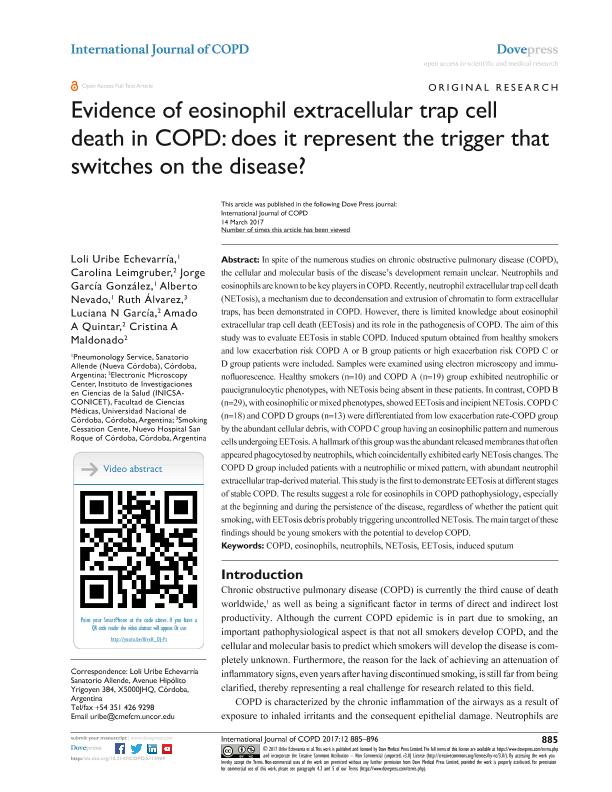Mostrar el registro sencillo del ítem
dc.contributor.author
Echevarría, Loli Uribe
dc.contributor.author
Leimgruber, Carolina

dc.contributor.author
García González, Jorge
dc.contributor.author
Nevado, Alberto
dc.contributor.author
Álvarez, Ruth
dc.contributor.author
García, Luciana Noemí

dc.contributor.author
Quintar, Amado Alfredo

dc.contributor.author
Maldonado, Cristina Alicia

dc.date.available
2018-11-12T15:50:54Z
dc.date.issued
2017-03
dc.identifier.citation
Echevarría, Loli Uribe; Leimgruber, Carolina; García González, Jorge; Nevado, Alberto; Álvarez, Ruth; et al.; Evidence of eosinophil extracellular trap cell death in copd: Does it represent the trigger that switches on the disease?; Dove Press; International Journal of COPD; 12; 3-2017; 885-896
dc.identifier.issn
1178-2005
dc.identifier.uri
http://hdl.handle.net/11336/64235
dc.description.abstract
In spite of the numerous studies on chronic obstructive pulmonary disease (COPD), the cellular and molecular basis of the disease’s development remain unclear. Neutrophils and eosinophils are known to be key players in COPD. Recently, neutrophil extracellular trap cell death (NETosis), a mechanism due to decondensation and extrusion of chromatin to form extracellular traps, has been demonstrated in COPD. However, there is limited knowledge about eosinophil extracellular trap cell death (EETosis) and its role in the pathogenesis of COPD. The aim of this study was to evaluate EETosis in stable COPD. Induced sputum obtained from healthy smokers and low exacerbation risk COPD A or B group patients or high exacerbation risk COPD C or D group patients were included. Samples were examined using electron microscopy and immunofluorescence. Healthy smokers (n=10) and COPD A (n=19) group exhibited neutrophilic or paucigranulocytic phenotypes, with NETosis being absent in these patients. In contrast, COPD B (n=29), with eosinophilic or mixed phenotypes, showed EETosis and incipient NETosis. COPD C (n=18) and COPD D groups (n=13) were differentiated from low exacerbation rate-COPD group by the abundant cellular debris, with COPD C group having an eosinophilic pattern and numerous cells undergoing EETosis. A hallmark of this group was the abundant released membranes that often appeared phagocytosed by neutrophils, which coincidentally exhibited early NETosis changes. The COPD D group included patients with a neutrophilic or mixed pattern, with abundant neutrophil extracellular trap-derived material. This study is the first to demonstrate EETosis at different stages of stable COPD. The results suggest a role for eosinophils in COPD pathophysiology, especially at the beginning and during the persistence of the disease, regardless of whether the patient quit smoking, with EETosis debris probably triggering uncontrolled NETosis. The main target of these findings should be young smokers with the potential to develop COPD.
dc.format
application/pdf
dc.language.iso
eng
dc.publisher
Dove Press

dc.rights
info:eu-repo/semantics/openAccess
dc.rights.uri
https://creativecommons.org/licenses/by-nc-sa/2.5/ar/
dc.subject
Copd
dc.subject
Eetosis
dc.subject
Eosinophils
dc.subject
Induced Sputum
dc.subject
Netosis
dc.subject
Neutrophils
dc.subject.classification
Medicina Critica y de Emergencia

dc.subject.classification
Medicina Clínica

dc.subject.classification
CIENCIAS MÉDICAS Y DE LA SALUD

dc.title
Evidence of eosinophil extracellular trap cell death in copd: Does it represent the trigger that switches on the disease?
dc.type
info:eu-repo/semantics/article
dc.type
info:ar-repo/semantics/artículo
dc.type
info:eu-repo/semantics/publishedVersion
dc.date.updated
2018-10-22T18:58:41Z
dc.identifier.eissn
1176-9106
dc.journal.volume
12
dc.journal.pagination
885-896
dc.journal.pais
Nueva Zelanda

dc.journal.ciudad
Auckland
dc.description.fil
Fil: Echevarría, Loli Uribe. Sanatorio Allende; Argentina
dc.description.fil
Fil: Leimgruber, Carolina. Consejo Nacional de Investigaciones Científicas y Técnicas. Centro Científico Tecnológico Conicet - Córdoba; Argentina. Universidad Nacional de Córdoba;Facultad de Ciencias Médicas;Cátedra de Bioquímica Molecular; Argentina
dc.description.fil
Fil: García González, Jorge. Sanatorio Allende; Argentina
dc.description.fil
Fil: Nevado, Alberto. Sanatorio Allende; Argentina
dc.description.fil
Fil: Álvarez, Ruth. Nuevo Hospital San Roque; Argentina
dc.description.fil
Fil: García, Luciana Noemí. Consejo Nacional de Investigaciones Científicas y Técnicas. Centro Científico Tecnológico Conicet - Córdoba; Argentina. Universidad Nacional de Córdoba;Facultad de Ciencias Médicas;Cátedra de Bioquímica Molecular; Argentina
dc.description.fil
Fil: Quintar, Amado Alfredo. Consejo Nacional de Investigaciones Científicas y Técnicas. Centro Científico Tecnológico Conicet - Córdoba; Argentina. Universidad Nacional de Córdoba;Facultad de Ciencias Médicas;Cátedra de Bioquímica Molecular; Argentina
dc.description.fil
Fil: Maldonado, Cristina Alicia. Consejo Nacional de Investigaciones Científicas y Técnicas. Centro Científico Tecnológico Conicet - Córdoba; Argentina. Universidad Nacional de Córdoba;Facultad de Ciencias Médicas;Cátedra de Bioquímica Molecular; Argentina
dc.journal.title
International Journal of COPD
dc.relation.alternativeid
info:eu-repo/semantics/altIdentifier/doi/https://dx.doi.org/10.2147/COPD.S115969
dc.relation.alternativeid
info:eu-repo/semantics/altIdentifier/url/https://www.dovepress.com/evidence-of-eosinophil-extracellular-trap-cell-death-in-copd-does-it-r-peer-reviewed-article-COPD
Archivos asociados
